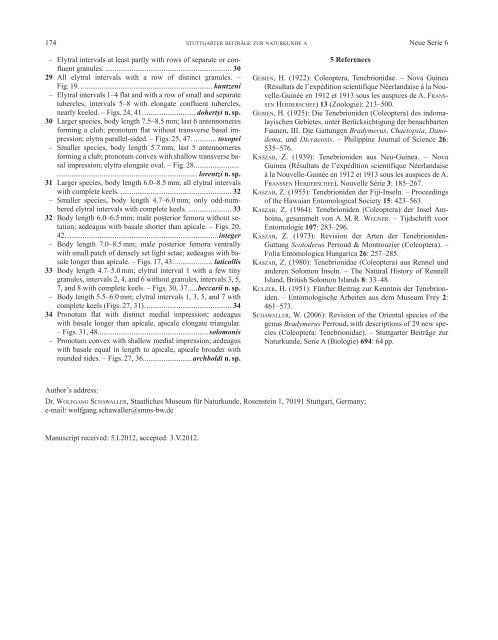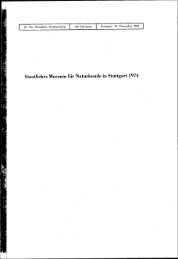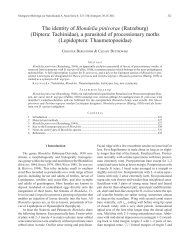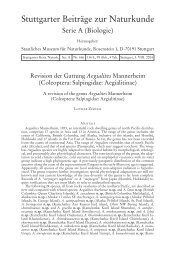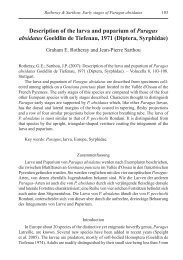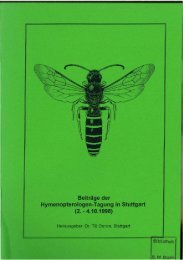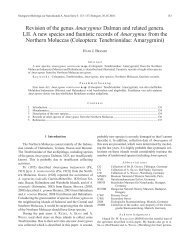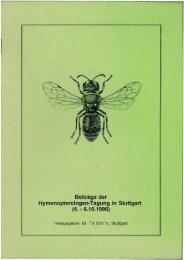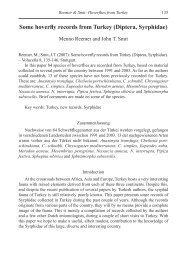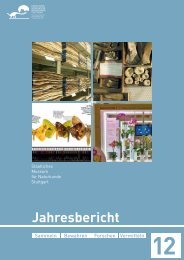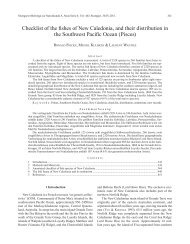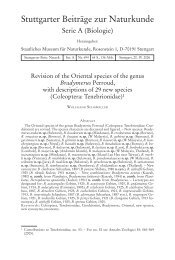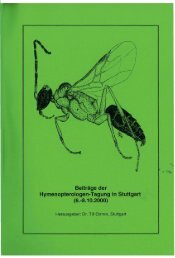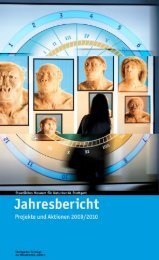The species of Bradymerus Perroud (Coleoptera: Tenebrionidae ...
The species of Bradymerus Perroud (Coleoptera: Tenebrionidae ...
The species of Bradymerus Perroud (Coleoptera: Tenebrionidae ...
Create successful ePaper yourself
Turn your PDF publications into a flip-book with our unique Google optimized e-Paper software.
174 STUTTGARTER BEITRÄGE ZUR NATURKUNDE ANeue Serie 6– Elytral intervals at least partly with rows <strong>of</strong> separate or confluentgranules. ................................................................... 3029 All elytral intervals with a row <strong>of</strong> distinct granules. –Fig. 19. ...................................................................... kuntzeni– Elytral intervals 1–4 flat and with a row <strong>of</strong> small and separatetubercles, intervals 5–8 with elongate confluent tubercles,nearly keeled. – Figs. 24, 41. ........................... dohertyi n. sp.30 Larger <strong>species</strong>, body length 7.5–8.5 mm; last 6 antennomeresforming a club; pronotum flat without transverse basal impression;elytra parallel-sided. – Figs. 25, 47. ............ toxopei– Smaller <strong>species</strong>, body length 5.7 mm; last 5 antennomeresforming a club; pronotum convex with shallow transverse basalimpression; elytra elongate oval. – Fig. 28. .................................................................................................. lorentzi n. sp.31 Larger <strong>species</strong>, body length 6.0–8.5 mm; all elytral intervalswith complete keels. ........................................................... 32– Smaller <strong>species</strong>, body length 4.7–6.0 mm; only odd-numberedelytral intervals with complete keels. ....................... 3332 Body length 6.0–6.5 mm; male posterior femora without setation;aedeagus with basale shorter than apicale. – Figs. 20,42. ................................................................................integer– Body length 7.0–8.5 mm; male posterior femora ventrallywith small patch <strong>of</strong> densely set light setae; aedeagus with basalelonger than apicale. – Figs. 17, 43. .................... laticollis33 Body length 4.7–5.0 mm; elytral interval 1 with a few tinygranules, intervals 2, 4, and 6 without granules, intervals 3, 5,7, and 8 with complete keels. – Figs. 30, 37. ....beccarii n. sp.– Body length 5.5–6.0 mm; elytral intervals 1, 3, 5, and 7 withcomplete keels (Figs. 27, 31). ............................................. 3434 Pronotum flat with distinct medial impression; aedeaguswith basale longer than apicale, apicale elongate triangular.– Figs. 31, 48. ..........................................................solomonis– Pronotum convex with shallow medial impression; aedeaguswith basale equal in length to apicale, apicale broader withrounded sides. – Figs. 27, 36. .........................archboldi n. sp.5 ReferencesGEBIEN, H. (1922): <strong>Coleoptera</strong>, <strong>Tenebrionidae</strong>. – Nova Guinea(Résultats de l’expédition scientifique Néerlandaise à la Nouvelle-Guinéeen 1912 et 1913 sous les auspices de A. FRANS-SEN HERDERSCHEE) 13 (Zoologie): 213–500.GEBIEN, H. (1925): Die Tenebrioniden (<strong>Coleoptera</strong>) des indomalayischenGebietes, unter Berücksichtigung der benachbartenFaunen, III. Die Gattungen <strong>Bradymerus</strong>, Chaetopsia, Danodema,und Dicraeosis. – Philippine Journal <strong>of</strong> Science 26:535–576.KASZAB, Z. (1939): Tenebrioniden aus Neu-Guinea. – NovaGuinea (Résultats de l’expédition scientifique Néerlandaiseà la Nouvelle-Guinée en 1912 et 1913 sous les auspices de A.FRANSSEN HERDERSCHEE), Nouvelle Série 3: 185–267.KASZAB, Z. (1955): Tenebrioniden der Fiji-Inseln. – Proceedings<strong>of</strong> the Hawaian Entomological Society 15: 423–563.KASZAB, Z. (1964): Tenebrioniden (<strong>Coleoptera</strong>) der Insel Amboina,gesammelt von A. M. R. WEGNER. – Tijdschrift voorEntomologie 107: 283–296.KASZAB, Z. (1973): Revision der Arten der Tenebrioniden-Gattung Scotoderus <strong>Perroud</strong> & Montrouzier (<strong>Coleoptera</strong>). –Folia Entomologica Hungarica 26: 257–285.KASZAB, Z. (1980): <strong>Tenebrionidae</strong> (<strong>Coleoptera</strong>) aus Rennel undanderen Solomon Inseln. – <strong>The</strong> Natural History <strong>of</strong> RennellIsland, British Solomon Islands 8: 33–48.KULZER, H. (1951): Fünfter Beitrag zur Kenntnis der Tenebrioniden.– Entomologische Arbeiten aus dem Museum Frey 2:461–573.SCHAWALLER, W. (2006): Revision <strong>of</strong> the Oriental <strong>species</strong> <strong>of</strong> thegenus <strong>Bradymerus</strong> <strong>Perroud</strong>, with descriptions <strong>of</strong> 29 new <strong>species</strong>(<strong>Coleoptera</strong>: <strong>Tenebrionidae</strong>). – Stuttgarter Beiträge zurNaturkunde, Serie A (Biologie) 694: 64 pp.Author’s address:Dr. WOLFGANG SCHAWALLER, Staatliches Museum für Naturkunde, Rosenstein 1, 70191 Stuttgart, Germany;e-mail: wolfgang.schawaller@smns-bw.deManuscript received: 5.I.2012, accepted: 3.V.2012.


